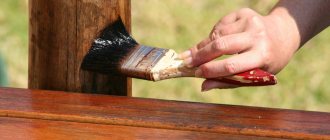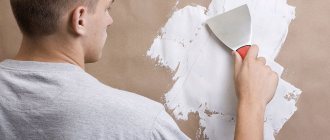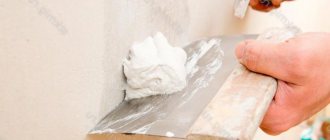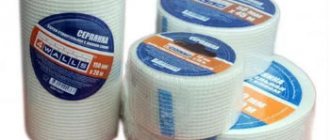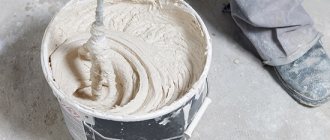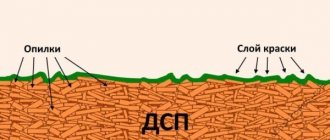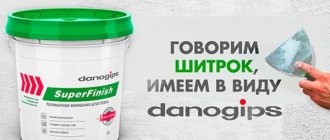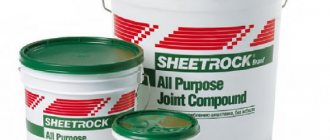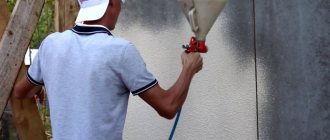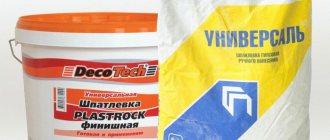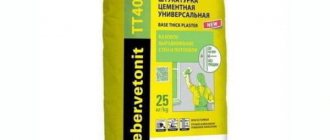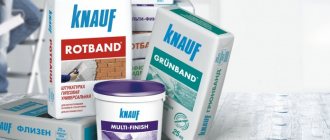The range of modern finishing materials for plaster and putty allows you to make walls perfectly even and smooth. Among the materials for final finishing, most practitioners especially highlight the finishing putty Sheetrock, or in the original version Sheetrock. Almost everyone who is capable of performing top-class finishing for painting is aware of its existence and capabilities. Shitrok is not cheap, so the finishing mass is used only as the last layer. You can buy several types of SuperFinish produced by Knauf Bauprodukte or APJC, produced at factories of Russian and Greek subsidiaries of the American United States Gypsum.
Main properties of Sheetrock APJC
You already know that the cream-like mass is ready for use immediately after opening the bucket. The product is usually white with a beige tint. It has a specific smell.
With Shitrokom we can not only putty ceilings and walls, structure the surface, but also seal seams between plasterboard sheets, cracks, glue gypsum boards together, and finish corners. True, many are of the opinion that Sheetrock is not entirely suitable for sealing seams formed between plasterboard sheets. Quite an expensive pleasure, and it is better to use Knauf Uniflott, a product designed specifically for this purpose. However, there are those who disagree with this point of view.
The putty has an oily consistency, thanks to which it holds well on the spatula and is easy to apply. When it dries, it becomes quite elastic and prevents cracks from occurring.
You can do a simple experiment. If you are working on a ceiling covered with gypsum board, plastered with Sheetrock, in which holes are cut out for lamps, then take one of the pieces and separate the drywall from the fiberglass treated with Sheetrock, and then bend the canvas. Even when the deformation angle reaches ninety degrees, cracks do not form.
The appearance of surfaces treated with Shitrok is amazing. They look dense and smooth, which cannot be achieved by using Vetonit. Drying occurs quickly. This process lasts from three to four hours. If you approach sanding surfaces with the utmost care, you will achieve an ideal result. Sanding does not cause any particular difficulties. However, when using Vetonit, these measures are easier to implement, because the latter is less dense. Choose an abrasive mesh whose grain size does not exceed one hundred and eighty units.
Continuous puttying involves applying APJC in two layers if there is no fiberglass on the surface. When it is used, it is better to apply three layers. Application of Sheetrock on a less dense putty is excluded in order to avoid gaps that may form due to the small thickness of the layer, as well as your excessive efforts.
Important! Do not apply putty if the indoor temperature drops below thirteen degrees Celsius.
Instructions for finishing seams
The material is applied to the joint with a narrow spatula. Next, a tape is applied to the surface, which should be fixed without pressure using a spatula. For best results, use paper tapes from the same manufacturer. The putty is accelerated along the tape from the middle to the edges.
The tape is glued by removing the excess layer from underneath it. The surface must be leveled and left until completely dry. Next, you should use a wider spatula, applying a layer on top of the tape. It should be 5 cm wider than the previous one on each side. As soon as the layer has dried, you can begin continuous leveling.
Advantages
- No difficulties to use. After opening the bucket, you can immediately start working. No kneading required. Minimum amount of waste. Holds perfectly on the spatula. Leveling is amazingly easy. Minor differences in layers.
- Simple sanding process. The result is surfaces of excellent quality. Provided that the sanding was done by professionals and two layers of paint were applied on top, then everything will look perfect.
- Long shelf life. Even if the bucket is left open all day, the remaining Shitrok will not harden.
- Convenience and durability of buckets. However, a seventeen-litre Sheetrock bucket weighs twenty-eight kilograms and is quite difficult for some people to carry.
Composition and characteristics of putty
The basis of the putty composition is limestone or dolomite, as well as vinyl acetate polymers. The content of talc, thickening elements and silicate minerals is acceptable. The color scheme is light beige, and the consistency is creamy. Left in a bucket with an airtight lid, the putty will keep for several months.
Shitrok putty is endowed with a large number of advantages , which are revealed during the process of its application:
- You can use the mixture immediately after opening the container (bucket).
- Easy application of the mixture due to density and concentration, which reduces the amount of time spent and additional cleaning after completion of work.
- Having high adhesion, even when applying several layers, Shitrok putty adheres tightly to the surface, leaving a high quality of work performed.
- The smooth surface is demonstrated by pasted wallpaper, through which blemishes and bulges are not visible.
- The shelf life, both open and closed, is longer than that of analogues.
- There is almost no shrinkage of the material.
- For Shitrok, the putty consumption is minimal.
- Ability to work in rooms with any humidity and temperature conditions.
- The material can interact with other compounds during application without losing its properties.
Analogs
It goes without saying that Shitrok has competitors. At least two analogues deserve close attention:
- Shelton (Bau Master);
- Multi-Finish (Knauf).
To be fair, it should be noted: in fact, there are more analogues, but in stores selling building materials they are less common.
The compositions mentioned above, judging by the descriptions, are similar in properties and are immediately ready for use. As soon as the necessary information about these products becomes available, we will definitely publish articles about them on our website.
We advise you not to miss new material. We guarantee that it will be interesting and useful to learn about all the intricacies of working with these mixtures.
Product varieties
Sheetrock products are manufactured in America and five European countries. The manufacturer's reputation for quality has been earned over a hundred years. Modern manufacturing technologies and unique composition make the product a universal material for interior and exterior decoration.
Today, there are three main types of putties on the construction market from the Ready-Mixed category (which means ready-to-use products):
- Sheetrock Fill Finish light. Used to smooth out minor defects, sometimes to laminate the surface. The latex component makes the material resistant to moisture and completely eliminates the possibility of cracking during use.
- Sheetrock Superfinish. This is Shitrok finishing putty. Can be applied as the final finishing coat. The material has high adhesion, but it is not sufficient for filling deep cracks and treating corners.
- Sheetrock All Purpose. This putty is considered universal, therefore suitable for any type of finishing. The product is often used for texturing and is sometimes used to fill spaces in brickwork.
The great thing is that the products are constantly being improved and improved to meet the needs of modern finishers and installation technologies.
Puttying walls with your own hands: first layer
Before puttying (first, subsequent and before wallpapering the walls), these same walls must be primed. This procedure is quite easy and quick. Using a roller (amply moistened with primer) you need to “wet” all the walls and let them dry.
The walls will take 30-90 minutes to dry. If one layer is not enough for you, then for prevention you can apply another one (after the first one has dried) - it won’t get any worse.) Well, I’ll limit myself to one, because I’m lazy. The time I spent on priming one room of 15 m2 was about 20 minutes.
| IMPORTANT: if you already have electricity connected, there are sockets and switches, prime these places more carefully (preferably with a brush) so that water does not get inside. A short circuit and electric shock will not be a pleasant experience. |
Photo 2. Puttying the wall, first layer.
We take a small spatula in one hand, with which you will scoop up the putty and apply it to a large one, in the other, a large spatula, with which we will apply the whole thing to the wall and begin to spread a thin layer of putty on the wall.
You should start from the left corner and move to the right. The movement of the spatula is diagonal, slightly in an arc, while the spatula should be held to the wall at an angle of 20-30 degrees. Try to pull one piece of putty out as far as possible. Do not try to fill large uneven areas in one go. The excess putty from the large spatula is collected with a small spatula.
Application rules
Cosmofen glue: instructions for use, characteristics, reviews
Before you start working with the material, you need to prepare the surface and buy a puttying tool.
Tools you will need:
- two spatulas – narrow (12.2 cm) and wide (25 cm);
- special Sheetrock Joint Tape or self-adhesive mesh “Strobe”;
- a piece of sandpaper;
- sponge.
The surface that will be puttied must first be cleaned of debris, dust, soot, grease stains, old paint, and wallpaper. Next, opening the container with the solution, you need to stir it lightly. Sometimes, due to excessive thickness, the solution is diluted with a small amount of purified water (maximum one glass of 250 ml)
It is important to know that the more water in the solution, the greater the likelihood of shrinkage
Using putty when processing internal and external corners
You know the consumption of “Shitroka” per 1 m2. However, before starting work, you should also learn about corner processing technology. It is necessary to prepare a piece of corner or tape in advance. To achieve an ideal result, you should use professional angles from the same manufacturer.
It is necessary to apply a layer of putty to the surface on both sides of the corner with a narrow spatula. A corner or tape is fixed to the surface. Under the tape, spread the material from the middle to the edges. This way you can stick the tape and remove the excess layer and level the surface. Next you should wait until it dries completely. Then you can apply a layer of tape or corner using a 30 cm spatula. As soon as the layer has dried, you can begin continuous puttying.
What is included in the finishing putty on m?
Rotband plaster instructions for use for beginners Since finishing putty is a layer that is called a smoothing layer, this type of “smoothing” requires precise calculation, because you are probably preparing the wall for painting, wallpapering or sculpting. The construction crews hired by ordinary people do not offer an accurate calculation of consumables, but a obviously larger quantity of them. This percentage does not always correspond to actual costs, but foreman-schemers, relying on the low cost of a bag of finishing material, often increase its quantity not by a couple of additional units of production, but by dozens.
Types of Shitrok putty
There are three types of Sheetrock putty.
1. SHEETROCK Taping Joint Compound, Ready-Mixed is a taping compound. This type is ideal for sealing cracks in plaster and for use in almost all plasterboard sheets where the most important quality is maximum strength and crack resistance. It also gives good results when laminating (applying thin layers). 2. SHEETROCK Topping Joint Compound, Ready-Mixed (finishing) is a putty with minimal shrinkage, easy to apply and sand. Recommended for applying the second and third coat over other types of putty (Sheetrock Taping and Sheetrock All Purpose). Suitable for applying simple textures. The strength of this type of putty is not sufficient for applying tape or sealing corners. 3. SHEETROCK All Purpose Compound, Ready-Mixed is used for taping and finishing, can also be used for hand texturing. Also recommended for laminating and repairing cracks in interior plaster and brickwork that are not exposed to moisture.
Sheetrock putty - manufacturers
United States Gypsum Company (USG), headquartered in Chicago (USA), is a major global manufacturer of finishing building materials, whose annual turnover has now reached 3.2 billion USD. The company arose about a hundred years ago as a result of the merger of several companies working with gypsum. The popularity of its products is evidenced by the fact that a sheet of drywall in the USA is called Sheetrock, and putty is also called Sheetrock. USG today produces and supplies putty for:
- suspended systems for ceilings;
- acoustic ceiling panels;
- plasterboard sheets;
- GKL seams and other necessary products.
The company's production facilities are located literally in all parts of the world, five of them are in Europe, and operate in a continuous cycle. The company recently acquired, along with the trademark rights, a well-known production of suspended ceilings in Germany and became known as USG / DONN.
How to prepare the solution for work
Sheetrock Superfinish putty is sold as a ready-made solution, but the composition should be thoroughly mixed before application to ensure uniformity after the product has been left in the bucket for a long time.
If the viscosity does not seem sufficient, then dilution with water is acceptable. But you cannot exceed the amount of 50-60 ml per liter of putty.
Sheetrock Superfinish putty is sold as a ready-made solution, but the composition should be thoroughly mixed before application.
Sheetrock, Knauf “Rotband paste” or Vetonit LR - which is better
The materials listed are the most popular among finishers. But there are features that must be taken into account when choosing. Thus, Shitrok creates the smoothest surface even without sanding. After sanding, it must be primed, but without sanding this step can be skipped. Shitrok is ideal for painting, the most durable.
Primer must be applied on top of Vetonit; this material is best suited for subsequent wallpapering. The disadvantage of Vetonit in comparison with Shitrok is less plasticity, but the color is perfectly white. Another disadvantage of Vetonit is the need for dilution, while Shitrok is a ready-made mass.
When comparing Shitrock and “Rotband paste” from Knauf, the following should be noted. There are few differences in the recipe; Knauf also makes high-quality material with small marble particles and a polymer matrix. The surface after finishing coating from Knauf remains perfectly smooth; it does not need to be polished or sanded. Typically, “Rotband paste” is purchased if a thicker layer is planned to seal wall defects. Shitrok involves thin application - up to 2 millimeters. You should select the material based on your needs - then the quality of the work will not cause any complaints.
Additional Information:
Ready-made Sheetrock 17 l is a highly effective putty building material, completely ready for use. High performance and technical characteristics of the products are due to the use of special technology and a range of special ingredients in production. The finished 17 liter sheetrock, due to the presence of vinyl fibers in the product, is capable of maintaining the plasticity of the resulting finish for a long time.
An important advantage of the product is the economical consumption of putty composition and quick drying. Practical putty Shitrok 28 is a completely ready-made composition for carrying out high-quality finishing work indoors. Therefore, Shitrok 17 putty eliminates errors that occur during the preparation of working compositions from analog building materials. There is also no need to worry if the Shitrok putty 17 l accidentally opened or remained after finishing. It won't dry out.
What are the advantages of Shitrok putty 17 l
It is worth noting that Shitrok 28kg putty is recommended for indoor use only. When carrying out exterior finishing and repair work in wet rooms, Shitrok putty 28 kg is not used by specialists, since it is not intended for such work
The ready-made universal mixture sheetrock 17l is suitable for processing almost all surfaces, from brickwork to plastered bases. It should be noted that after the finished sheetrock 28 kg has been applied to the surface to be treated, compositions with chemicals cannot be used in subsequent treatments.
Ready-made sheetrock 17 l is extremely easy to use
In order to achieve an ideal processing result, the ready-made putty mixture Shitrok 17 l is applied only to a cleaned base. If the surface to be treated is porous, it is recommended to prime the work area before applying Shitrok 28 putty.
If plastering processes are carried out beforehand, it is important to select compatible building materials, preferably from the same manufacturer. For example, a guaranteed high result of repair work is achieved if plaster and putty Shitrok 17 are used
If Shitrok 17L putty is used on plasterboard structures, they must be assembled according to the technology. It is also important to take into account that Shitrok putty 17 l is used in finishing work at a maintained temperature above +13 degrees.
The economical putty Shitrok 28 kg is extremely convenient to use. For 1 sq. meter of treated area requires about 400 grams of product. This putty building material is relevant during work on sealing seams between walls, sheets of drywall and other building materials.
What is the effectiveness of the putty product?
- This composition is ready to use; no mixing is required. The building material is extremely elastic and can be applied without problems, significantly reducing the time spent on repairs,
- universal putty Shitrok 28 kg - the optimal putty composition for treating a range of old surfaces, porous concrete, gypsum fiber, plasterboard, concrete bases,
- high-quality sealing of corners and seams can be ensured by ready-made sheetrock putty mixture 17 l,
- the product is excellent for use as a finishing layer for finishing,
- sheetrock 28 kg ready-made is used by specialists for applying tapes without gluing them,
- This putty composition is environmentally friendly and guarantees high results of repair work in a short period of time.
SuperFinish
| Filler | Marble |
| Binder | Ethylene-vinyl acetate copolymer |
| Average fraction | 60 µm Sieve residue 160 µm <= 0.01% Sieve residue 250 µm = 0% |
| Recommended application thickness | Up to 2 mm |
| White | At least 88% |
| Mixture consumption | 1 l/m2/mm |
| Density | 1.60 g/cm3 |
| Frost resistance | 5 cycles |
| Drying time per layer | Varies depending on air temperature, relative humidity and type of room. For example, according to plasterboard at Humidity 30%, temperature +20°, layer thickness 0.25 mm - complete drying -2 hours Gypsum plaster: Humidity +50%, temperature +15°, layer thickness 0.8 mm, complete drying -15 hours . |
| Mixing | Stir with a spatula before use. |
| Room temperature | More than 13° |
| Package | Bucket 17l ~28 kg, Bucket 11l. ~18 kg, Bucket 3.5 l. ~5.6 kg. |
Advantages
- Ready to use
- Excellent as a finishing layer
- Exceptional elasticity
- Withstands repeated freezing/thawing
- Layer thickness up to 2 mm
- Ideal for mineral surfaces
Preparing for work
Lightly stir the contents of the bucket. If necessary, the putty can be diluted with water: add water in small portions of 50-60 ml, stir. Avoid over-thinning the putty as this may cause uneven shrinkage and poor adhesion to the surface. The Instructions for Use section will also follow:
Leveling surfaces
Apply putty to a dry, dust-free surface. Each subsequent layer of putty is applied after the previous layer has completely dried. It is recommended to work with putty at temperatures above 13 degrees Celsius, because this significantly reduces drying time. When dry sanding, use 240 grit sandpaper or less.
Sealing seams
Fill the gypsum board joint with putty using a spatula. Press the Sheetrock paper joint tape down the center. Using a spatula with a blade width of more than 14cm. remove excess putty from under the paper joint tape. After drying, apply the next layer until the seam is completely level with the surface of the drywall. Apply the required number of layers of putty to the places where the gypsum board is attached.
Processing internal corners
Apply putty to both sides of the corner, approximately 4 cm wide on each side. Fold the Sheetrock paper connector tape down the center along the fold line. Press the tape to the corner with a spatula, remove excess putty from under the tape. For ease of processing the surface of the tape, apply putty to one side of the corner, and after drying, treat the other side.
Processing external corners
Apply putty to the surface of the corner to be treated, place a metal corner on Sheetrock paper backing to the corner and use a spatula to squeeze out excess putty from under the corner. After drying, apply a second and, if necessary, a third layer of putty, after the second layer has dried.
Storage
Thaw frozen putty to room temperature; do not speed up the defrosting process using heating devices and hot water. After defrosting, stir thoroughly until any irregularities and air bubbles are eliminated. If the recommendations are followed, the putty fully retains all consumer properties after repeated freezing/thawing.
Store putty in buckets with tightly closed lids in a dry place at room temperature. Protect the putty bucket from excessive heat and storage in direct sunlight.
The putty has a shelf life of 12 months from the production date (the production date is indicated on the bucket).
Safety precautions
When working with plaster, the following precautions must be taken:
- if the solution gets into the eyes, wash them with plenty of running water;
- during the grinding process, wear safety glasses, a respirator and gloves;
- the material is stored out of the reach of children;
- If accidentally swallowed, induce vomiting, rinse the stomach, or seek medical attention.
Consumption: Approximately 1 kg of Shitrok putty is used for 1m2. This is explained by the fact that after drying the material does not “shrink”. The oily structure also reduces consumption, ensuring smooth gliding over the surface. Consumption of Sheetrock putty for processing drywall seams is 28 kg/55 m2, for texture – 28 kg/20 m2.
Application options for Shitrok putty
Finishing seams with Shitrok putty
- fill the seams with a 12 cm spatula;
- Apply tape in the center;
- press the tape firmly;
- remove excess putty and apply a thin layer to the tape;
- putty the screw heads;
- after the first layer has dried, apply the second layer (20 cm spatula, 5 cm on each side outside the first layer);
- drying the second layer;
- apply a thin finishing layer to the seam (trowel 25 cm);
- apply a thin finishing layer to the screws;
- If necessary, smooth it with a damp sponge after drying.
Note: finishing seams is the most complex operation that requires highly qualified performers, therefore, to prevent shrinkage cracks, the thickness of the applied layer should be no more than 1-2 mm.
Shitrok putty - finishing internal corners
- apply putty to both sides of the tape with a 12 cm spatula;
- fold the tape lengthwise in the middle and press it to the corner with a spatula;
- remove excess putty and apply a thin layer over the tape;
- drying;
- apply a second layer on one side;
- drying;
- apply a second layer on the other side;
- drying;
- If necessary, wipe with a damp sponge.
Finishing external corners
- fix the metal corner profile;
- apply 3 layers of putty with appropriate drying, make the second layer wider than the first by 10-15 cm (20 cm spatula), bring the third layer slightly beyond the second (25 cm spatula);
- smooth with a damp sponge.
Sanding putty
Avoid sanding if possible due to dust and unfavorable working conditions. If sanding is still necessary, use sandpaper wrapped around a damp sponge to avoid dust and to avoid damaging the cardboard of the sandpaper.
- when the putty is dry to the touch, you need to squeeze the water out of the sponge (so as not to drip);
- Rub the seams with light movements to remove any bulges (try to do the minimum number of movements!);
- rinse the sponge.
Dry sanding
For dry sanding, use 120 grit (fine) sandpaper, avoid abrasion of the paper.
Surface decoration
All surfaces prepared for processing, including a layer of putty on the seam, must be dry, free of dust and dirt, and not have a glossy surface.
- Sheetrock First Coat primer or undiluted high-solids latex paint is applied;
- Then you should proceed according to the instructions for painting or texturing (decorating) in the corresponding instructions.
